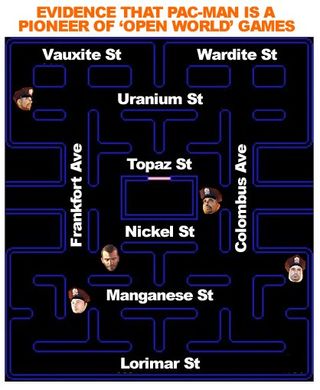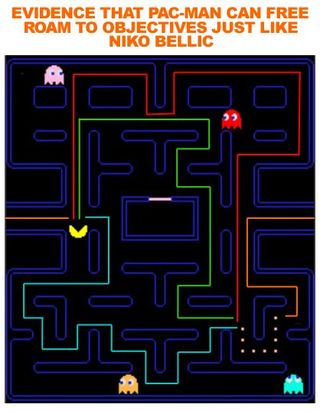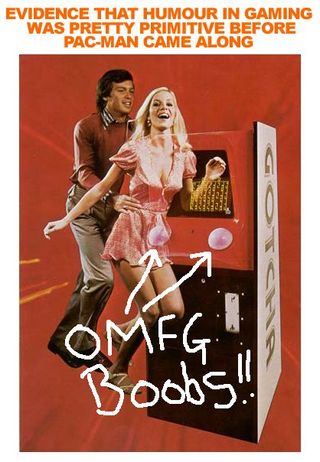GTA IV's Liberty City may very well be equal to the size of a small moon, but the single-screen world that Pac-Man inhabits really isn't that dissimilar. Just imagine Pac-Man's maze as a top-down approximation of a small section of Liberty City. If you're having trouble with that, take a look at our Pac-Man version of downtown Algonquin, complete with street names. We've even replaced Pac-Man with the disembodied head of Niko Bellic. And the ghosts with LCPD. That's how thorough we're being here.

The maze walls define pathways and are non-traversable, exactly like the majority of buildings that define the streets of Liberty City. The 'edges' of both worlds are restricted by barriers. Pac-Man is free to roam wherever he pleases within the defined game space of the maze. Niko Bellic is free to roam within the defined game space of Liberty City. Both characters are free to choose their own path through their respective worlds. Both characters can follow a non-linear path to an objective. For example, see how Pac-Man can choose multiple routes in the image below to reach the final dots in order to clear the maze and complete his objective.

Obviously Liberty City is a vastly bigger and more complex open world than Pac-Man's comparatively infinitesimal labyrinthine universe. Pac-Man doesn't require GPS to find his way around. And he won't get busted for shooting a prostitute with a carbine assault rifle. But you can't argue that the fundamental principles of an open world are present in Pac-Man.
It introduced gamers to cut-scenes. And LOLZ!
Every game before Pac-Man was non-stop 'action'. It was one level after another after another after another and so on. There was no respite. Just hurtling progression through wave after wave of enemies moving at incrementally faster speeds. But Pac-Man gave gaming its first cut-scene. After clearing the first two mazes, players were treated to an interval without any demand for interaction.
Even more impressive was that the short sequence was actually funny. Not pee-pee in your panties funny, but it would definitely warrant an internet endorsed LOLZ had the internet existed in 1980 and someone without anything better to do had taken it upon themselves to post a movie of the cut-scene on the 1980 equivalent of YouTube. Luckily, it's 2009 and we have the internet, so you can see the LOLZ worthy Pac-Man cut-scene in the movie below. Which we took the trouble of recording ourselves because we had nothing better to do.
And while we're on the subject of LOLZ, it's worth noting that Pac-Man was also light years ahead in terms of humour. In addition to the amusing cut-scene, it had comical enemies - the rather jolly Blinky, Pinky, Inky and Clyde - which had a natural talent for making players smile. Their frightened little faces when Pac eats a power pill and disembodied eyes once eaten by Pac was always worth a grin.
Perhaps not comedy gold, we know, but consider that arcade gaming's finest attempt at humour to that point in history had been the coin-operated curio, Gotcha - a maze game that pre-dated Pac-Man by some seven years. Not a funny game, but Gotcha's cabinet featured two pink replica boobs instead of joysticks. They were manipulated by the player's hands to control the game. It was designed to be a crude representation of fondling breasts. This is what Gotcha looked like:

There are other facets of Pac-Man that have been widely discussed regarding its greatness and lasting contribution to gaming as we recognise it today. So we'll only give the subjects a cursory mention here. Pac-Man's 'Power Pill' is one of the earliest examples of a power-up and certainly one of the most well known. And, of course, there is the behaviour of the ghosts, which in 1980 was the most complex example of enemy intelligence that gaming had ever seen. It's still revered as being very much awesome to this very day. If you want to go unfathomably deep into how the ghost patterns were determined during play, we can highly recommend this incredible Gamasutra article on the subject.
In closing, we conclude that Pac-Man was so many light-years ahead of its time that creator Toru Iwatani must have been from the future. It's the only rational explanation.

September 10, 2009


Waka waka waka waka waka etc

The smallest things make all the difference

25medium-changing masterpieces

